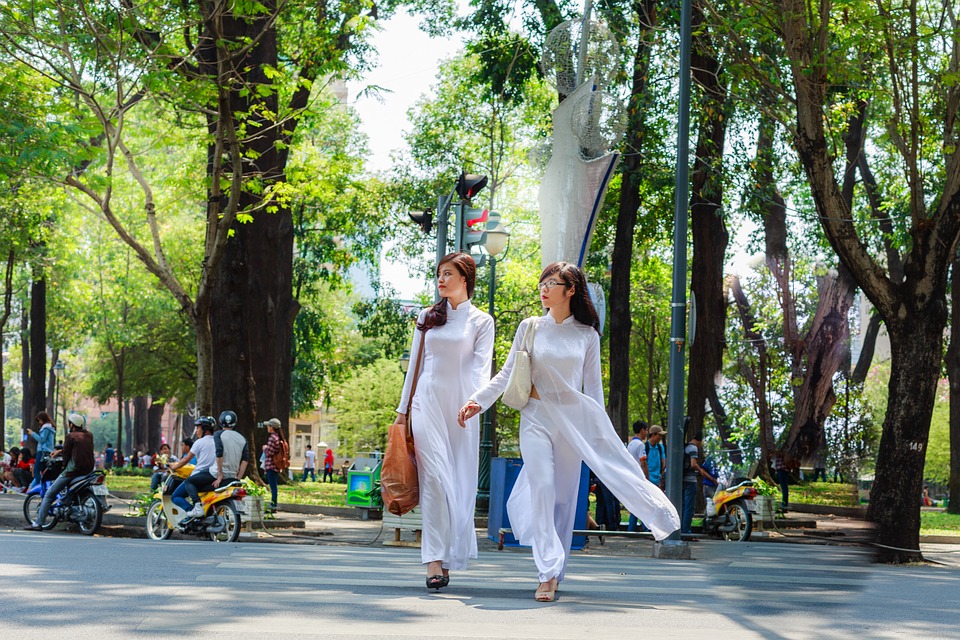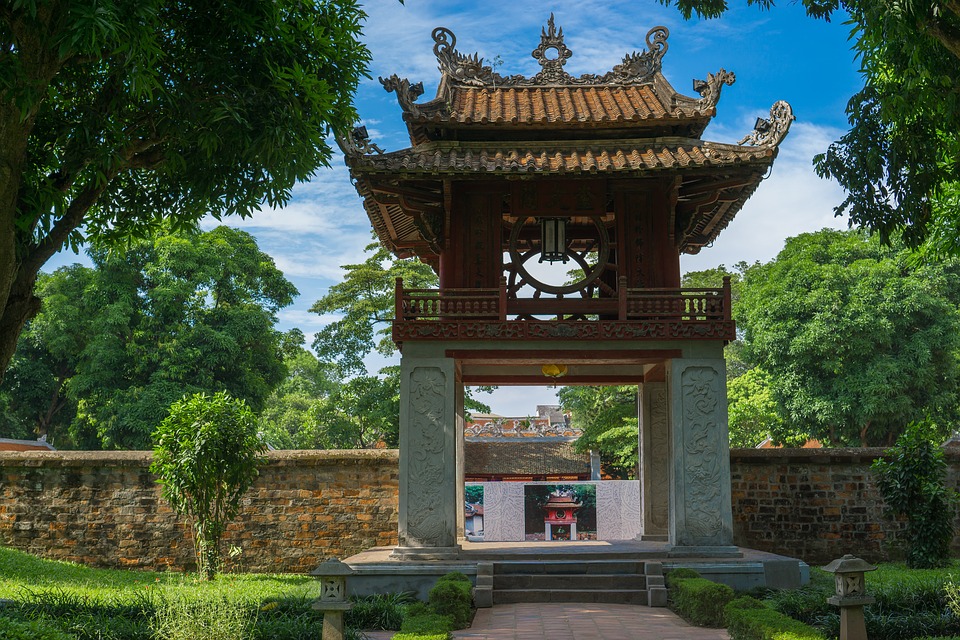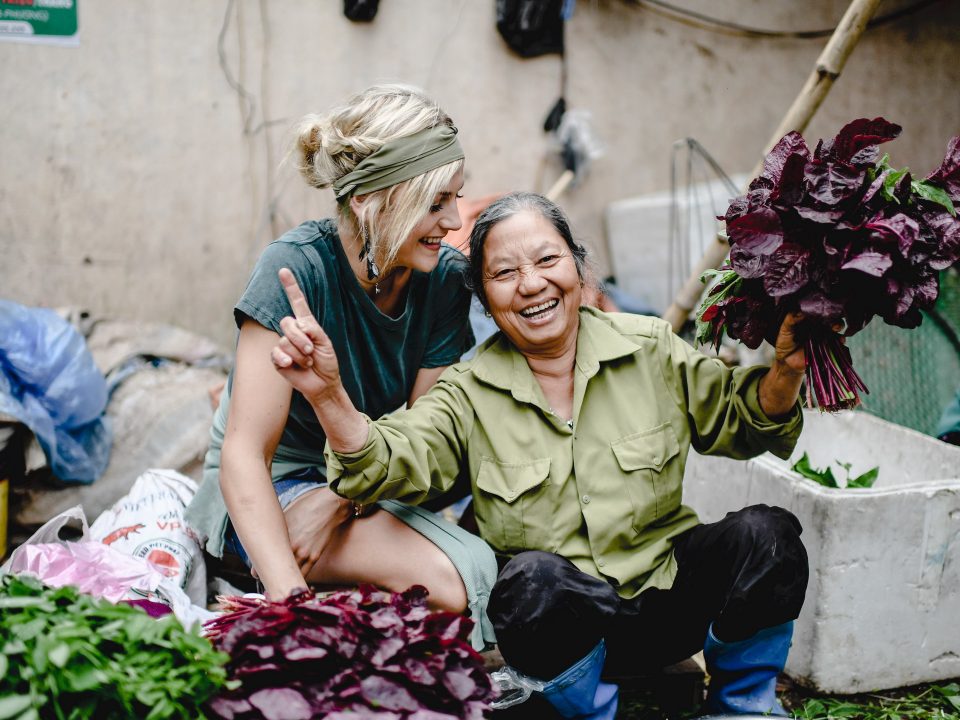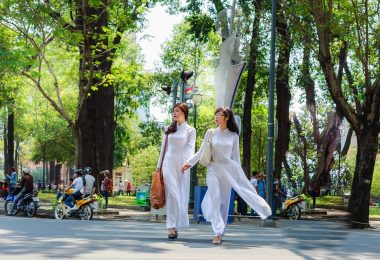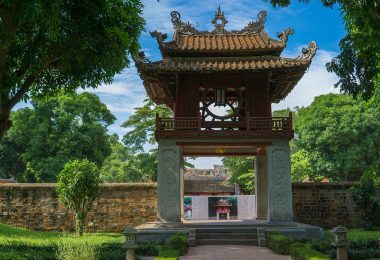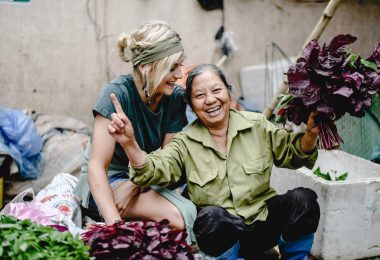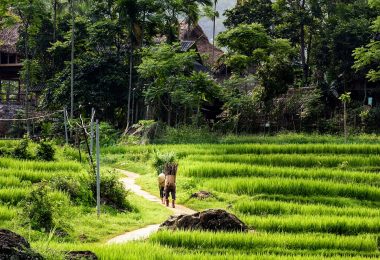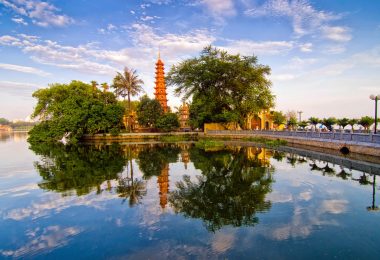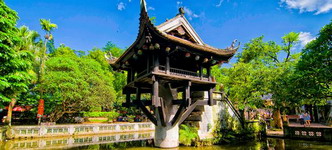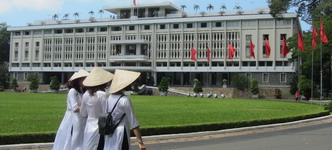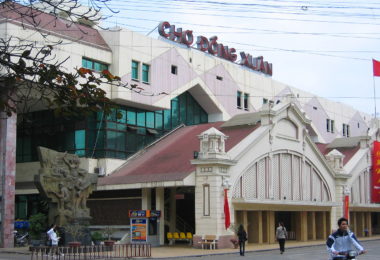Peach blossoms are especially bright during the Tet festival and spring season. In Northern Vietnam, peach tree branches are also used as Tet decorations. However, few people understand why it is related to the celebration.
Legend of the Tet Peach Branch
On the eastern slope of Soc Son Mountain stood an ancient peach tree, its sprawling branches and dense foliage casting a generous canopy of shade. This venerable tree was home to two deities, Tra and Uat Luy. Known for their benevolence, these guardian spirits played a crucial role in the lives of the local people. They tirelessly protected the villagers, keeping malevolent demons and evil spirits at bay, ensuring peace and safety in the region.
Each year during Tet, the guardians would meet the Jade Emperor in heaven, leaving the earthly realm unprotected and susceptible to mischief. To safeguard their homes during this vulnerable period, people started placing peach blossoms in vases or hanging drawings of the deities on red paper at their doorways.
This practice started as a way to seek protection and became a beloved Tet tradition. Peach blossoms and deity drawings symbolized protection and good luck, reflecting the community’s hopes for a prosperous year. Over time, it maintained cultural significance, combining respect for the divine with Tet’s joyful celebration.
Although belief in the supernatural has waned among Vietnamese people, the enduring tradition of adorning homes with peach blossoms and vibrant red papers inscribed with hopeful wishes for a prosperous new year persists steadfastly. Rooted deeply in Vietnamese culture, this practice symbolizes optimism and good fortune, ensuring that the New Year is celebrated with enthusiasm and reverence.
Importance of Tet Peach Blossom Branch
Over the years, peach blossoms have come to embody various sentiments such as beauty, warmth, joy, love, and hope, particularly during the Lunar New Year. They symbolize not only graceful beauty and close friendships but also an ancient pledge of brotherhood. Today, a garden adorned with peach blossoms evokes a deep sense of tradition, fostering strong bonds among friends and loved ones.
Spiritually, peach branches hold significant meaning as tools to ward off demons, a practice upheld especially on Tet, the Vietnamese New Year’s Eve. During this time, it’s customary for people to place peach branches at their home’s entrance to safeguard against malevolent forces. Valued highly in Feng Shui for their protective qualities, families plant peach trees in front of their homes during the New Year to ensure good fortune and ward off evil spirits.
Peach blossoms are not merely beautiful flowers; they also hold significant symbolic value as harbingers of renewal and growth, particularly cherished during the Lunar New Year festivities. Embedded in ancient beliefs, these blossoms evoke a profound sense of new beginnings and promising futures, embodying the festive spirit and aspirations for prosperity that mark this auspicious time of year.
Northern Vietnam Prefers Peach Blossoms: Exploring Regional Preferences
Spring is a time of new growth and vibrant flowers. Every Tet holiday, Vietnamese homes are adorned with either peach blossoms in the North or apricot blossoms in the South. This regional preference is rooted in climate, weather, and cultural beliefs, as explained in the book “100 Things to Know about Vietnamese Customs.”
-
Northern and Southern Region Weather and Climate
Plum blossoms are low-maintenance plants that grow well in pots or in the ground, requiring moist soil and sunlight but avoiding waterlogging. They flourish in temperatures above 28 degrees Celsius, making them well-suited for the late-year climate in Southern. Conversely, cherry blossoms prefer cooler climates, such as those found in Northern regions, and struggle to bloom in warmer areas. Historically, due to underdeveloped flower delivery services between North and South Vietnam, people favored locally-adapted plants for Tet holiday decorations. Over time, this practice shaped unique regional customs for displaying and appreciating these floral beauties.
-
Customs in Northern and Southern Regions
The apricot blossom is one of the revered four noble plants, alongside pine, bamboo, and chrysanthemum, often celebrated in poetry and art. In Southern Vietnamese culture, its yellow hue symbolizes the earth element, embodying prosperity and wealth.
The apricot tree’s strong roots represent resilience against storms and winds. They symbolize virtues such as patience and noble sacrifice. In Southern Vietnam, during Tet, the Vietnamese Lunar New Year, homes are decorated with yellow apricot blossoms to bring luck and good wishes for the upcoming year.
In Northern Vietnam, peach blossoms are preferred over apricots. Celebrated for their beauty, they symbolize harmony between heaven and earth. In feng shui, they are valued for warding off negativity and bringing tranquility and joy throughout the year.
According to Northerners, peach blossoms ward off evil spirits. They’re commonly planted in front of homes during Tet and spring. Peach blossoms symbolize the beauty of Northern girls—reserved, graceful, and gentle. That’s why Northerners choose them to wish for a lucky, safe, and prosperous new year.
Northerners’ Tet Peach Blossom Arrangements Unveiled
Let Impress Travel expertly navigate you through the intricate process of selecting and arranging these exquisite blooms, meticulously curated to adorn both private residences and public spaces. These flowers epitomize the essence of Tet, symbolizing new beginnings and ushering in auspicious blessings with their vibrant colors and delicate fragrances.
Essential Tips for Selecting Lunar New Year Peach Blossoms
- Choosing Peach Trees for Planting:
Vietnamese plant peach trees with strong roots and thick trunks to keep them fresh without roots getting tangled or branches drooping. They choose trees with evenly spread small branches that have buds. They also make sure the trees have healthy blooms without pests, with petals that are intact, and they match the tree’s appearance to its pot.
- Pruning Peach Tree Branches:
When Vietnamese people prune branches, their goal is to achieve a rounded shape that evenly distributes flowers along each branch. They carefully space out smaller branches, preferring a natural curve over perfect straightness to maintain balance and harmony. By cutting fresh from the tree, they ensure the branches appear healthy and encourage robust growth.
- Buying Peach Blossom Branches:
During Tet holiday, Vietnamese traditionally purchase peach blossom branches several days in advance to ensure they bloom at the auspicious time. Potted peach trees, although aesthetically pleasing, bloom at a slower rate compared to pruned branches. People choose potted trees with lots of blossoms that bloom just in time for Lunar New Year.
Essential Tips for Decorating with Peach Blossoms to Suit Every Home Space
In Vietnamese homes, the placement of peach blossoms during Tet reflects careful consideration of space and aesthetic harmony. In larger, airy spaces, the focal point is often a centrally positioned peach blossom pot, selected for its substantial size to enhance the room’s grandeur. This choice not only emphasizes the festive spirit but also serves as a visual centerpiece, drawing attention to its vibrant blooms.
Conversely, in smaller living rooms, Vietnamese tradition adapts by acquiring peach branches, elegantly arranged in vases atop tea tables. These vases typically stand about 1 meter tall, with branches spanning approximately 0.5 meters. Such dimensions are meticulously adjusted to suit the available space, ensuring that the display maintains a proportional balance. This approach prevents the branches from overwhelming the modest tea table or appearing diminutive in a larger setting.
In these setups, color is really important. Vietnamese decorators pick peach blossoms that stand out against the walls. In smaller or darker spaces, they like lighter colors like white or light peach to make things brighter and more noticeable. Conversely, in brighter, more expansive spaces, deeper shades like pink or goat’s breath peach are favored, imparting a warmer ambiance to the surroundings.
Exploring Vietnam’s Most Expensive Peach Blossom Tree Variety
It would be a significant omission not to acquaint oneself with the That Thon peach variety, also known as the “peach of the royal progress." Historically, this esteemed fruit was reserved solely for the elite and Vietnamese monarchs. Today, the fascination with this peach variety persists, embodying both luxury and cultural heritage.
A small That Thon peach tree, 30-40 cm tall, costs between 2,000,000 VND and 2,500,000 VND per pot. These miniature trees offer a glimpse of the larger ones’ splendor. Larger, more magnificent specimens can fetch prices from tens to hundreds of millions of dong, reflecting their rarity and beauty.
Notably, the ancient That Thon peach trees, steeped in history and tradition, are particularly prized. These venerable trees, with their enduring legacy and cultural significance, are esteemed at an astonishing 160 million dong, representing a blend of botanical rarity and historical reverence.
The That Thon peach variety embodies Vietnamese heritage, symbolizing more than just fruit. Each tree not only produces fruit but also holds a story of prestige, exclusivity, and royal patronage. This variety highlights Vietnam’s cultural significance and historical allure, reflecting a deep connection to its royal past.
In conclusion
Peach blossoms are highly valued in Vietnamese culture, especially during Tet. They symbolize vitality, luck, and renewal, representing the hopes and dreams of Vietnamese people during the Lunar New Year. With their pink petals and sweet scent, peach blossoms decorate homes and streets, reminding everyone of Tet’s cultural and spiritual importance. By cherishing these traditions, we recognize how peach blossoms bring joy, prosperity, ensuring they remain an essential part of Tet celebrations for generations.
Don’t forget to regularly follow our Facebook page and Website for more interesting information about traveling to Hanoi and to book Hanoi tours at the best prices.





























